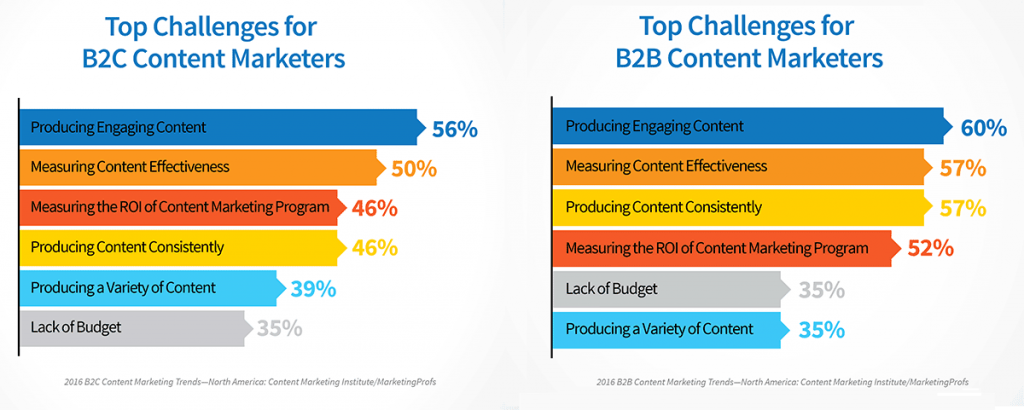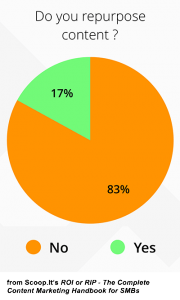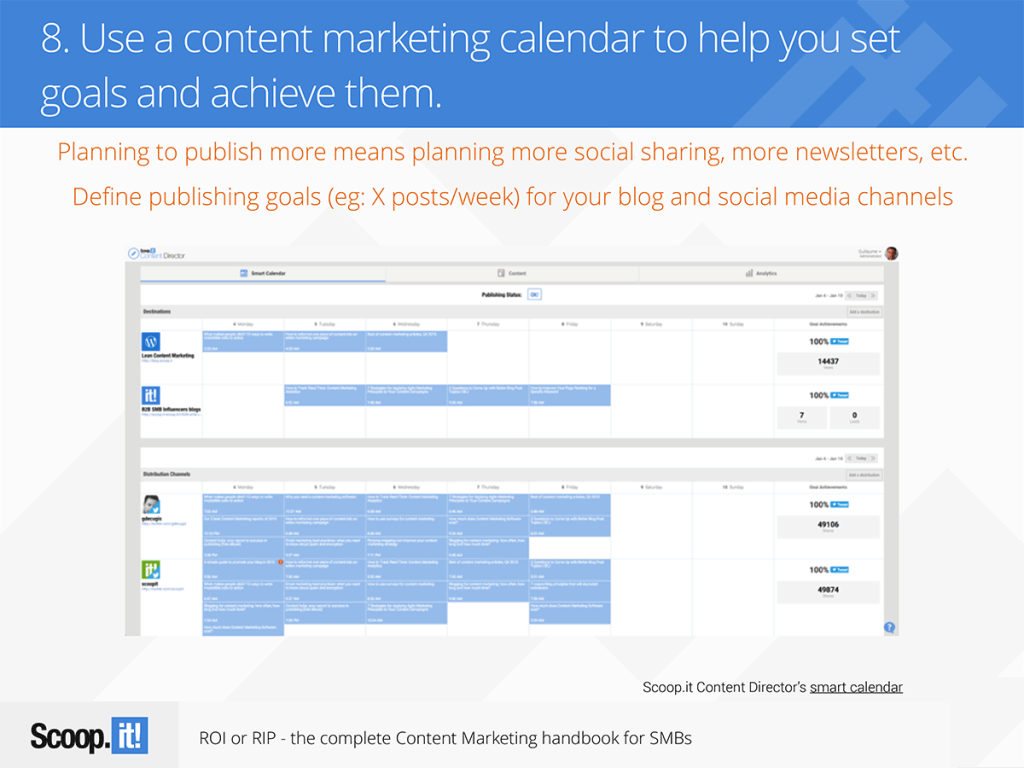
Got marketer’s overwhelm? Boy, are you not alone. While we’re living in one of the best times ever to work in marketing, everything about it is evolving fast. There’s content to create, audiences to build, a new social media platform every year (or more) and a dozen different skills and software applications to master.
While it can feel like a lot sometimes, it can also be an exhilarating ride. Apply these 15 tips as often as you can – so you can ride the wave of content marketing, not get washed under it.
1. Don’t practice “random acts of content”
In other words, have a strategy. A data-based strategy. And follow it. Every piece of content you publish should be in line with your content strategy.
Want to know more about developing a content marketing strategy? See our blog post, “How to revamp your content marketing strategy [with worksheets]”.
2. Keep checklists and develop standard operating procedures (SOPs)
Airplane pilots use checklists religiously. They won’t even turn on a plane’s engine until they’ll run through several system checks, and all that gets done with checklists.
This is because they can’t forget anything, their work has to be perfect, and they have dozens of things to check and do – often with constant interruptions. So to make sure there are no mistakes, they keep checklists. This makes their work faster and far more error-free.
We marketers might not be managing a 747, but sometimes all the inputs from our marketing can be as intimidating as a pilots’ dashboard.
We’ve also got one more reason for checklists: They make it easier to outsource your tasks. Training someone when you have a detailed checklist is way more efficient than just walking them through the process (over and over again).
3. Curate
One of the biggest challenges content marketers face is keeping up with content creation. It’s a major balancing act to publish high-quality content frequently enough. But it’s also a necessity – we know that Google (and Bing) crave fresh content, and our audiences do too.

So what to do? Well, you can actually use other people’s content – if you do it right. The key is to
- Always give people credit for their work.
- Include a link back to the original work (where possible).
- Add your own “spin” or commentary to what you share. This last part is really important – it’s what makes curation curation and adds a lot of value to the content.
You can use content curation almost anywhere – on social media, in blog posts, in your email newsletters and elsewhere. Up to 30% of the content you publish can be curated.
See our ebook, How to improve SEO – the power of content curation for more ideas on how to implement curation and the benefits it can provide. And of course, sign up for Scoop.It, the highly-rated content curation tool.
4. Control your inbox
Modern office workers sometimes spend as much as 25% of their time in their inboxes. This is obviously a massive block to your efficiency. The solution? There are a couple, actually:
- Borrow from one of the other tips here, “batch your work”: Contain your email management time to a few blocks a day. Otherwise, ignore it and focus on your deadlines and other tasks. Trust me, all that email will be there when you get back. (Extra tip: Also try tools like Unroll.me to mass unsubscribe from email lists you no longer want to be on.)
- Move project management out of your inbox: We love email, but it can make project management and collaboration with teams really difficult. So use a tool meant for those purposes. The new Scoop.it Content Director software is specifically designed to let teams manage every aspect of content marketing.
5. Minimize meetings
Meetings are tricky. You need them – the Content Marketing Institute and Marketing Profs 2016 B2B Content Marketing Trends report found that 61% of the most effective B2B marketers meet daily or weekly. Not only do meetings take up time, but excessive meetings can drain productivity and reduce employee morale.
So try to find the balance.
- Consider limiting your meetings to 30 minutes.
- Work tends to fill the time allocated for it. There’s even a name for this phenomenon. It’s called Parkinson’s Law.
- Try standing meetings. Some companies have cut meeting times by 25% with this trick.
- Only include people who absolutely have to be in the meeting. Let everyone else go do their work.
6. Repurpose content
 This is one of the best efficiency practices in content marketing. Sadly, only 17% of us are doing it.
This is one of the best efficiency practices in content marketing. Sadly, only 17% of us are doing it.
Want to be among that 17%? Read up:
Bonus: Update old content, too. This is a great way to leverage the enormous amount of work you’ve done over time. Anything that hasn’t been updated in the last year is due for a refresh.
7. Get free help with some content creation
Guest bloggers are a boon to any blog. The trouble is finding the right people, convincing them to write, then editing and scheduling their content. Webinars and ebook can also be co-produced. Some companies have even handed over a social media account to an influencer for a day. For more information about how to do this, see our blog post, “Get influencers and subject matter experts to contribute to your blog”.
8. Outsource what you can
Got any tasks that feel a bit repetitive – or that require special skills you may not have? Seriously consider outsourcing them. Here are a few services and websites that can take those tasks off your to-do list:
- Fancy Hands: Hire a virtual assistant in 20-minute blocks.
- Design Pickle or Undullify: Get your own ace designer for $129 a month and up.
- Fiverr: Almost like eBay for creative and professional services.
- 99 Designs: Get a boatload of designs made for anything from a logo to a website and beyond. Only pay for the design you like best.
- Visual.ly: Expensive, but high-quality visual content a la carte.
- Website maintenance: Stop fighting with WordPress. There are a bunch of affordable services that can make your site perform at its best.
- Content writing services like ExpressWriters or Copyblogger’s list of certified content marketers.
- Virtual assistant services like Red Butler or MyTasker.
- Errands and other in-person tasks TaskRabbit, Thumbtack or Craigslist.
9. Automate what you can
This can free up as much as 25% of your time. There’s utterly no reason you should be manually posting to your social media accounts, for instance. And it’s actually possible to nearly automate the creation your weekly newsletter, too. You can even partially automate re-posting old content, and set up reminders for when content needs to be refreshed.
If you get really fancy, a tool like Scoop.it Content Director will automatically look through all your content and tell you things like:
- Which pieces of content don’t have a call to action
- Which pieces of content are getting a very low conversion rate (and thus may need a different call to action, or an update)
- Which pieces of content are getting an unusually high conversion rate (and thus deserve to be reposted to your social media accounts for extra exposure)
10. Batch your work
Shifting tasks and multitasking are far less effective than they seem. That’s why grouping similar tasks together can speed up work – and by a lot. According to Psychology Today, “you can lose up to 40% of your productivity if you multi-task.”
11. Use a content hub
Are you spending precious minutes looking for an old blog post? Or an image? Or an audio file from a few months ago? Stop! Organize your content into a content hub so you and your audience can find your content fast.
We’re huge fans of content hubs. So much so, that we asked Barry Feldman to write an eBook about it, “Content Hubs Are Here”. There’s a blog post, too.
12. Buff up your skills
Do you struggle with Excel? Flop around in Photoshop? Those are big time wasters. So if you can’t outsource this work, learn how to do it faster. Lord knows there are plenty of online tutorials for Excel and Photoshop and just about anything else on YouTube. Lynda.com is also pretty good. Even 15 minutes of study can speed up your work.
13. Use an editorial calendar
Surprises are not good for efficiency. Neither is having to drop everything because a deadline has snuck up on you.
So don’t let this happen. Use an editorial calendar to plan out everything you’re going to publish. Then build in events around the publication date, like time for a designer to make some graphics, time for an editor to review a draft, and time for you to review the final product before it all goes live.
We’re fond of the editorial calendar in Scoop.it Content Director, but you could also use Trello or Google Calendar for your editorial calendar.
14. Use templates
Okay… here’s a dirty secret: Not all content is completely, 100% unique.
By that, I mean that many marketers use templates for their work. Maybe it’s an image template, or a social media post template, or a blog post template. Or my favorite – the landing page template.
Whatever the content format, smart marketers find templates or make their own. They can pull a template up and customize it in half the time it would take to start from scratch.
15. Regularly assess what’s working and what’s not
Even if you perfectly followed all the first fourteen suggestions here, if you’re using a tactic that isn’t working anymore, you’re not really being efficient. Busy – yes. But efficient – in terms of generating business? No.
So take some time to evaluate your content’s performance. You don’t need to do it every day, or even every week. But at least once a month, we recommend you step back and see how your content is performing. And then, of course, adjust your day-to-day practices to reflect what’s working best.
Conclusion
We marketers are busier than ever, but there are plenty of tools and tactics to help us maximize our time. Use those tools and tactics well, and you’ll get far better results, you won’t have to work until after nine every night, and you might even snag a raise.
Back to you
What do you do to maximize efficiency? Got any content marketing automation tricks you particularly like? Share your tips in the comments.
If you want to get 30 effective techniques to master content marketing along with valuable insights from 10+ influencers like Mark Schaefer, Rebecca Lieb, Lee Odden, Jason Miller or Ian Cleary, download our free eBook now!
Image by Tom Hall.




Good article! People ask to use my content all the time, which benefits us both because it gives their audience some content but they also link back to my sites. It’s been a slow process getting a network of people to retweet, link to my content and sites but it keep steadily increasing my web traffic.
Very Impressive Article. I agree here – Guest bloggers are a boon to any blog. The trouble is finding the right people, convincing them to write, then editing and scheduling their content. Webinars and e-book can also be co-produced. Some companies have even handed over a social media account to an influencer for a day’…Keep Writing Pam!